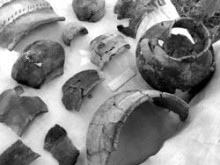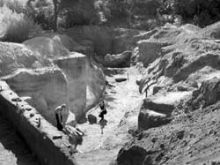For the past fifteen years local archeologists have been digging on the site of an ancient settlement on the elevated left-bank terrace of the River Ingul, several blocks away from the historic heartland of Mykolayiv. Although discovered by archeologist Feodosiy Kaminsky in the late 1920s, the ancient settlement, dubbed the Wild Garden, did not become a site of regular archeological excavations until 1990. Digging on a most promising site spanning three hectares, archeologists have unearthed six houses, two utility structures, five ancient shrines, a ritual stairway following the line of sunrise on solstice day and leading to the main shrine where sacral rituals were performed, as well as decorated pottery work of various sizes and artifacts of bronze, stone, clay, and bone. This collection of materials has now enabled scholars to reconstruct the lifestyle and religious beliefs of the people inhabiting this region at the turn of the second and first millennia BC. However, this year’s digs have led to truly sensational discoveries.
Until recently the Wild Garden was considered a traditional agricultural settlement. Yet the discoveries of this archeological season indicate the presence of an ancient settlement with a unique system of architectural structures, a material culture, and an extensive network of defensive fortifications at the heart of present-day Mykolayiv. Judging by the results of these excavations, the ancient fortifications consisted of a five-meter-wide and two- meter-deep ditch and a low rampart, or wall built of clay on a stone base, which protected the inhabitants from raids from the west, south, and north, while a steep, sloping bank of the River Ingul protected them on the east side. In peacetime a drawbridge was used to cross the ditch. Its base of large limestone slabs has been preserved almost intact in the lower part of the ditch. According to docent Yury Hrebennykov and senior instructor Kyryl Horbenko, the leaders of the archeological expedition organized by the V.A. Sukhomlynsky Mykolayiv State University, this is the first time that such an extensive system of fortifications dating to the second and first millennia BC has been unearthed in the Black Sea steppe.
According to Yury Hrebennykov, chair of the World History Department at Mykolayiv State University, Nadiya Havryliuk, chair of the Field Committee of the Ukrainian National Academy of Sciences, and Valentyna Krapyvina, head of the expedition to the ancient Greek settlement of Olvia, the Wild Garden settlement appeared on the territory of what is now Mykolayiv as early as the twelfth and eleventh centuries BC, i.e., approximately 500 years before the founding of the Greek city-state of Olvia, whose ruins were also unearthed in Mykolayiv oblast and which are now a national preserve.
The settlement existed for two to three hundred years at the turn of the Bronze and Iron Ages until the ninth century BC. Until now archeologists merely hypothesized that a proto-city might be buried underground. Today, the latest archeological discoveries have proved its existence. Hrebennykov thinks that the Wild Garden may be the city of the Cimmerians, which was described by Homer.
During a recent public news conference held on the site of the excavations, the archeologists displayed part of the excavated ditch, a defensive wall on the north side, the remains of the drawbridge, a rigging shop, a kitchen and a storeroom, and structures that may have served as watchtowers.
Aside from these structures, the archeologists have unearthed thousands of earthenware fragments, a mold for casting weapons and jewelry, clay molds for casting bronze items, stone and bone tools, and numerous fragments of horse bridles that were mass produced from antlers. This proves that the inhabitants of the settlement were skilled craftsmen with strong cultural and economic ties linking them to the centers of ancient civilizations in Southern and Central Europe. The Wild Garden may have been a river trade terminal, with merchant routes from Asia Minor, Western Europe, and the Mediterranean Sea converging on it. The archeologists have also unearthed a shrine where the inhabitants worshipped the sun. Already ten years ago they discovered a ceramic disk bearing symbols of linear script B from the Cretan-Mycenaean period.
Olvia expedition head Valentyna Krapyvina and Archeology Institute Field Committee chair Nadiya Havryliuk believe that the newly excavated settlement is a unique example of an ancient settlement discovered on the territory of a modern city. Once the archeological season is over, they will submit an official report to the Ukrainian Ministry of Culture and a letter on behalf of the Ukrainian National Academy of Sciences with a request to preserve the settlement. They are worried by a decision of Mykolayiv City Hall to earmark the site for a residential housing project. Yet they are certain that the city fathers will revise their decision, which will only benefit the city. With minimum investment in the preservation of the historical site — scholars are ready to suggest some very inexpensive technologies — it may be possible to boost Mykolayiv’s image as a tourist attraction.








